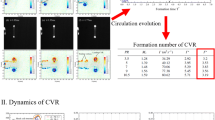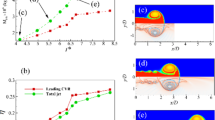Abstract
An experiment was conducted to investigate the flow structures in the compressible starting jet from two beveled nozzles (45\(^{\circ }\) and 30\(^{\circ }\) nozzle angles) of a shock tube using the schlieren technique. In the present study, the pressure ratios between the driver section and the driven section (PR) of 3.5, 7, and 10.5 corresponding to the shock wave Mach numbers (\(M_\mathrm{s}\)) of 1.28, 1.48, and 1.59 were applied to produce three types of compressible vortex rings (CVRs). Owing to the beveled nozzle, the shock wave diffracts twice to produce two coaxial CVRs. For PR = 3.5 with 45\(^{\circ }\) beveled nozzle, two shock-free CVRs are formed and merged into one primary CVR, while the two CVRs are separated from each other for the 30\(^{\circ }\) beveled nozzle. The main reason is that the strength of the secondary CVR generated from the 30\(^{\circ }\) beveled nozzle is much lower than that of the leading CVR. As for PR =7 and 10.5, the embedded shock and counter-rotating vortex rings (CRVRs) appear and constraint the formation of the secondary CVR. As a result, the two CVRs are merged into a primary CVR at a very early stage. In addition, for the two different beveled nozzles, the embedded shock–CVR, CRVR–CVR, and shock cell-trailing vortices interactions are observed and exhibited some differences. Moreover, by identifying the position of the primary CVR, it is found that the propagation velocity of the primary CVR generated from the beveled nozzles is significantly slower than that from a straight nozzle.
Graphic abstract












Similar content being viewed by others
References
Anderson J (1990) Modern compressible flow with historical perspective. Fluid Dyn Res 237–238
Arakeri J, Das D, Krothapalli A, Lourenco L (2004) Vortex ring formation at the open end of a shock tube: A particle image velocimetry study. Phys Fluids 16:1008–1019
Brouillette M, Hebert C (1997) Propagation and interaction of shock-generated vortices. Fluid Dyn Res 21:159–169
Cheng M, Lou J, Lim TT (2015) Leapfrogging of multiple coaxial viscous vortex rings. Phys Fluids 27:031702
Dora CL, Murugan T, De S, Das D (2014) Role of slipstream instability in formation of counter-rotating vortex rings ahead of a compressible vortex ring. J Fluid Mech 753:29–48
Elder F, Haas D (1952) Experimental study of the formation of a vortex ring at the open end of a cylindrical shock tube. J Appl Phys 23:1065–1069
Gurzhii AA, Konstantinov MY, Meleshko VV (1988) Interaction of coaxial vortex rings in an ideal fluid. Fluid Dyn 23:224
Helmholtz H (1858) Über integrale der hydrodynamischen gleichungen, welche den wirbelbewegungen entsprechen. J Reine Angew Math 1858:25–55
Hicks WM (1992) On the mutual threading of vortex rings. Proc R Soc Lond A 102:111–131
Kollmann W, Prieto M (2013) Dns of the collision of co-axial vortex rings. Comput Fluids 73:47–64
Kontis K, An R, Edwards J (2006) Compressible vortex-ring interaction studies with a number of generic body configurations. AIAA J 44:2962–2978
Lim T (1997) A note on the leapfrogging between two coaxial vortex rings at low reynolds numbers. J Phys Soc Jpn 9:239–241
Mariani R, Kontis K (2009) Effects of exit nozzle diameter on compressible vortex rings flow structure. AIAA J 410
Mariani R, Kontis K (2010) Experimental studies on coaxial vortex loops. Phys Fluids 22:126102
Minota T (1997) Dynamic motion of a compressible vortex ring. Proc SPIE Int Soc Opt Eng 3173:241–248
Moore D, Pullin D (1987) The compressible vortex pair. J Fluid Mech 187:171–204
Murugan T, Das D (2010) Characteristics of counter-rotating vortex rings formed ahead of a compressible vortex ring. Exp Fluids 49:1247–1261
Oshima Y (1975) Interaction of two vortex rings moving along a common axis of symmetry. J Phys Soc Jpn 38:1159
Oshima Y (1978) The game of passing-through of a pair of vortex rings. J Phys Soc Jpn 45:660
Qin L, Xiang Y, Lin HY, Liu H (2020) Formation and dynamics of compressible vortex rings generated by a shock tube. Exp Fluids 2020:61–86
Qin SY, Liu H, Xiang Y (2017) Lagrangian flow visualization of multiple co-axial co-rotating vortex rings. J Vis 21:63–71
Qin SY, Liu H, Xiang Y (2018) On the formation modes in vortex interaction for multiple co-axial co-rotating vortex rings. Phys Fluids 30:011901
Satti J, Peng J (2013) Leapfrogging of two thick-cored vortex rings. Fluid Dyn Res 45:035503
Shariff K (1992) Vortex rings. Annu Rev Fluid Mech 24:235–279
Sinha A, KGudmundsson, Xia H Colonius T (2016) Parabolized stability analysis of jets from serrated nozzles. J Fluid Mech 78:36–63
Sun M, Takayama K (2003) Vorticity production in shock diffraction. J Fluid Mech 478:237–256
Tophøj L, Aref H (2013) Instability of vortex pair leapfrogging. Phys Fluids 25:014017
Yu Q, Grönig H (1996) Shock waves from an open-ended shock tube with different shapes. Shock Waves 6:249
Zaman KBMQ (1999) Spreading characteristics of compressible jets from nozzles of various geometries. J Fluid Mech 383:197–228
Zare-Behtash H, Kontis K, Gongora-Orozco N, Takayama K (2009) Compressible vortex loops: effect of nozzle geometry. Int J Heat Fluids Flow 30:561–576
Zhang H, Chen Z, Guo Z, Zheng C, Xue D (2018) Numerical investigation on the three-dimensional flow characteristics of unsteady subsonic elliptic jet. Comput Fluids 160:78–92
Acknowledgements
The authors would like to acknowledge the financial support of the NSFC Project (NO. 91441205, NO. 91941301). Besides, this work was also supported by China Postdoctoral Science Foundation (NO. 2018M642007).
Author information
Authors and Affiliations
Corresponding author
Additional information
Publisher's Note
Springer Nature remains neutral with regard to jurisdictional claims in published maps and institutional affiliations.
Rights and permissions
About this article
Cite this article
Qin, L., Xiang, Y. & Liu, H. Vortex–shock and vortex–vortex interactions in the compressible starting jet from two beveled nozzle configurations. J Vis 24, 225–236 (2021). https://doi.org/10.1007/s12650-020-00700-8
Received:
Revised:
Accepted:
Published:
Issue Date:
DOI: https://doi.org/10.1007/s12650-020-00700-8




